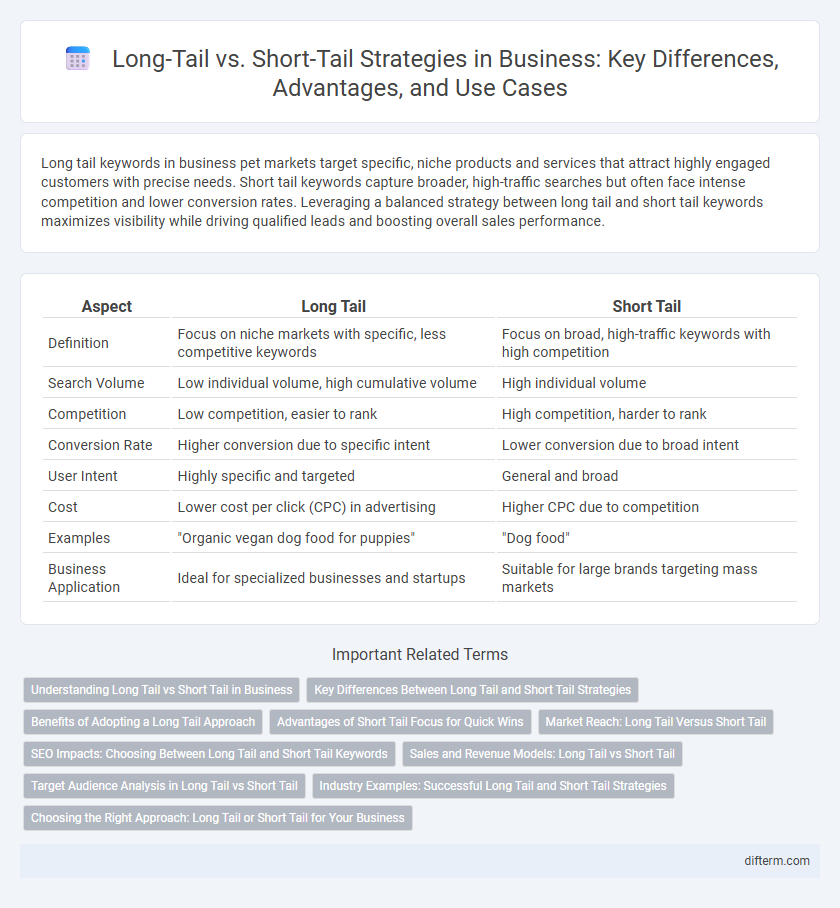Long tail keywords in business pet markets target specific, niche products and services that attract highly engaged customers with precise needs. Short tail keywords capture broader, high-traffic searches but often face intense competition and lower conversion rates. Leveraging a balanced strategy between long tail and short tail keywords maximizes visibility while driving qualified leads and boosting overall sales performance.
Table of Comparison
| Aspect | Long Tail | Short Tail |
|---|---|---|
| Definition | Focus on niche markets with specific, less competitive keywords | Focus on broad, high-traffic keywords with high competition |
| Search Volume | Low individual volume, high cumulative volume | High individual volume |
| Competition | Low competition, easier to rank | High competition, harder to rank |
| Conversion Rate | Higher conversion due to specific intent | Lower conversion due to broad intent |
| User Intent | Highly specific and targeted | General and broad |
| Cost | Lower cost per click (CPC) in advertising | Higher CPC due to competition |
| Examples | "Organic vegan dog food for puppies" | "Dog food" |
| Business Application | Ideal for specialized businesses and startups | Suitable for large brands targeting mass markets |
Understanding Long Tail vs Short Tail in Business
Long Tail business strategies focus on selling a large volume of niche products with low demand, leveraging digital platforms and e-commerce to reach diverse customer segments. Short Tail strategies concentrate on high-demand products with broad appeal, optimizing inventory and marketing for mass-market efficiency. Understanding the differences between Long Tail and Short Tail enables businesses to balance product variety, customer reach, and profitability in competitive markets.
Key Differences Between Long Tail and Short Tail Strategies
Long tail strategies target a large number of niche markets with specialized products or keywords, driving steady, diverse revenue streams through lower competition and higher customer specificity. Short tail strategies focus on high-volume, broad keywords or products that attract large audiences and generate rapid traffic but face intense competition and often lower conversion rates. Businesses choose between these approaches based on market goals, competitive landscape, and product range to optimize visibility and profitability.
Benefits of Adopting a Long Tail Approach
Adopting a long tail approach in business significantly increases market reach by targeting niche segments with specific demands, resulting in diversified revenue streams and reduced competition. This strategy improves customer satisfaction through personalized products or services, enhancing brand loyalty and retention rates. Companies leveraging long tail tactics also benefit from lower marketing costs per sale and greater adaptability to changing consumer preferences.
Advantages of Short Tail Focus for Quick Wins
Short tail keywords generate higher search volumes, enabling businesses to quickly attract a broad audience and boost immediate visibility. Their competitive nature often brings rapid traction in paid advertising campaigns, leading to faster conversion rates. Focusing on short tail terms accelerates brand recognition and supports swift returns on marketing investments.
Market Reach: Long Tail Versus Short Tail
Long tail markets target niche audiences with specialized products, resulting in a wide array of offerings that collectively generate significant revenue despite lower individual demand. Short tail markets concentrate on a few high-demand products appealing to broad audiences, optimizing mass-market reach and higher volume sales. Businesses leveraging the long tail can capture diverse customer segments, while short tail strategies maximize impact through popular, widely recognized products.
SEO Impacts: Choosing Between Long Tail and Short Tail Keywords
Long tail keywords drive higher conversion rates by targeting specific search intents, making them essential for niche markets and improving SEO rankings with less competition. Short tail keywords generate higher search volume but face intense competition, often requiring larger budgets and sophisticated strategies to achieve visibility. Balancing long tail and short tail keywords enhances organic traffic by combining broad reach with targeted user engagement, optimizing overall search engine performance.
Sales and Revenue Models: Long Tail vs Short Tail
Short tail sales focus on high-demand products that generate rapid revenue through volume and immediate market impact, often relying on a few best-selling items to drive profits. Long tail sales leverage a wide variety of niche products with lower individual demand but collectively create substantial revenue by targeting diverse customer needs over time. Revenue models for long tail emphasize scalable inventory and digital distribution, while short tail revenue models prioritize fast turnover and mass market appeal.
Target Audience Analysis in Long Tail vs Short Tail
Long tail keyword strategies target niche markets with specific audience needs, resulting in higher conversion rates and engaging highly interested customers. Short tail keywords attract a broader, more general audience, often leading to higher competition and lower conversion specificity. Understanding the target audience's search intent is crucial for selecting between long tail and short tail keywords to optimize marketing effectiveness.
Industry Examples: Successful Long Tail and Short Tail Strategies
E-commerce giant Amazon exemplifies successful long tail strategy by offering millions of niche products beyond popular bestsellers, capturing diverse customer interests and driving substantial cumulative sales. In contrast, Apple demonstrates an effective short tail approach by concentrating on a limited range of high-demand products like the iPhone and MacBook, maximizing brand strength and market dominance. Both strategies leverage tailored inventory and marketing tactics aligned with industry dynamics to optimize revenue and customer engagement.
Choosing the Right Approach: Long Tail or Short Tail for Your Business
Choosing the right approach between long tail and short tail keywords depends on your business goals and target audience. Long tail keywords attract highly specific traffic with lower competition, ideal for niche markets and higher conversion rates. Short tail keywords generate higher search volume but face intense competition, making them suitable for brands seeking broad exposure and rapid growth.
Long Tail vs Short Tail Infographic

 difterm.com
difterm.com